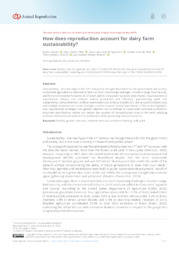How does reproduction account for dairy farm sustainability?
How does reproduction account for dairy farm sustainability?
Author(s): DIAVÃO, J.; SILVA, A. S.; SGUIZZATO, A. L. L.; SILVA, C. S. da; TOMICH, T. R.; PEREIRA, L. G. R.
Summary: Sustainability - the new hype of the 21st century has brought discomfort for the government and society. Sustainable agriculture is essential to face our most concerning challenges: climate change, food security, and the environmental footprint, all of which add to consumers' opinions and choices. Improvements in reproductive indexes can enhance animal production and efficiency, guaranteeing profit and sustainability. Estrus detection, artificial insemination (AI), embryo transfer (ET), estrus synchronization (ES), and multiple ovulations are some strategies used to improve animal reproduction. This review highlights how reproductive strategies and genetic selection can contribute to sustainable ruminant production. Improved reproductive indices can reduce the number of nonproductive cows in the herd, reducing methane emissions and land use for production while preserving natural resources.
Publication year: 2023
Types of publication: Journal article
Unit: Embrapa Dairy Cattle
Observation
Some of Embrapa's publications are published as ePub files. To read them, use or download one of the following free software options to your computer or mobile device. Android: Google Play Books; IOS: iBooks; Windows and Linux: Calibre.
Access other publications
Access the Agricultural Research Database (BDPA) to consult Embrapa's full library collection and records.
Visit Embrapa Bookstore to purchase books and other publications sold by Embrapa.

